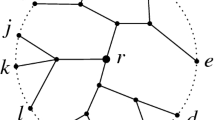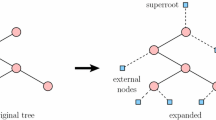Abstract
Two points p and q in a simple polygon P are k-visible when the line segment pq crosses the boundary of P at most k times. Given a query point q, a positive integer k, and a polygon P, we design an algorithm that computes the region of P that is k-visible from q in O(nk) time, where n denotes the number of vertices of P. This region is called the k-visibility region of q. This is the first algorithm parameterized in terms of k, resulting in an asymptotically faster worst-case running time compared to previous algorithms when k is \(o(\log {n})\), and bridging the gap between the O(n)-time algorithm for computing the 0-visibility region of q in P and the \(O(n\log n)\)-time algorithm for computing the k-visibility region of q in P for any k.
We also design a data structure of size O(n5) that supports visibility queries, returning the k-visible region of P for any arbitrary query point q in \(O(\log {n}+m)\) time, where m denotes the number of vertices on the boundary of the output visibility region.










Similar content being viewed by others
Notes
All indices are computed modulo the size of the corresponding vertex set: m + 1 in this case.
References
Aichholzer, O., Fabila-Monroy, R., Flores-Peñaloza, D., Hackl, T., Huemer, C., Urrutia, J., Vogtenhuber, B.: Modem illumination of monotone polygons. Comput. Geom. 68, 101–118 (2018)
Alt, H., Godau, M.: Computing the fréchet distance between two polygonal curves. Int. J. Comput. Geom. Appl. 5(01n02), 75–91 (1995)
Aronov, B., Guibas, L. J., Teichmann, M., Zhang, L.: Visibility queries and maintenance in simple polygons. Discrete Comput. Geom. 27(4), 461–483 (2002)
Bahoo, Y., Banyassady, B., Bose, P., Durocher, S., Mulzer, W.: A time-space trade-off for computing the k-visibility region of a point in a polygon. Theor. Comput. Sci. (2018)
Bajuelos, A., Canales, S., Hernández, G., Martins, M.: A hybrid metaheuristic strategy for covering with wireless devices. J. Univers. Comput. Sci. 18(14), 1906–1932 (2012)
Ballinger, B., Benbernou, N., Bose, P., Damian, M., Demaine, E., Dujmović, V., Flatland, R., Hurtado, F., Iacono, J., Lubiw, A., et al.: Coverage with k-transmitters in the presence of obstacles. J. Comb. Optim. 25(2), 208–233 (2013)
Birchfield, S.: An introduction to projective geometry (for computer vision). Unpublished note, Stanford university (1998)
Bose, P., Lubiw, A., Munro, J.: Efficient visibility queries in simple polygons. Comput. Geom. 23(3), 313–335 (2002)
Brink, W.: Lecture notes in computer vision, Fall (2017)
Cannon, S., Fai, T., Iwerks, J., Leopold, U., Schmidt, C.: Combinatorics and complexity of guarding polygons with edge and point 2-transmitters. arXiv:1503.05681 (2015)
Chang, H. C., Erickson, J., Xu, C.: Detecting weakly simple polygons. In: Proceeding 26th ACM-SIAM Symposium on Discrete Algorithms (SODA, pp 1655–1670 (2014)
Chazelle, B.: Triangulating a simple polygon in linear time. Discrete Comput. Geom. 6(3), 485–524 (1991)
Davis, L., Benedikt, M.: Computational models of space: isovists and isovist fields citeseer (1979)
De Berg, M., Cheong, O., Van Kreveld, M., Overmars, M.: Computational Geometry: Introduction. Springer, Berlin (2008)
Dean, J., Lingas, A., Sack, J.: Recognizing polygons, or how to spy. Vis. Comput. 3(6), 344–355 (1988)
Duque, F., Hidalgo-Toscano, C.: An upper bound on the k-modem illumination problem. arXiv:1410.4099 (2014)
El Gindy, H., Avis, D.: A linear algorithm for computing the visibility polygon from a point. J. Algorithms 2(2), 186–197 (1981)
Hoffmann, K., Mehlhorn, K., Rosenstiehl, P., Tarjan, R.: Sorting Jordan sequences in linear time using level-linked search trees. Inf. Control. 68 (1-3), 170–184 (1986)
Huang, H., Ni, C., Ban, X., Gao, J., Schneider, A., Lin, S.: Connected wireless camera network deployment with visibility coverage. In: INFOCOM Proceedings IEEE, pp 1204–1212. IEEE (2014)
Joe, B., Simpson, R.: Corrections to lee’s visibility polygon algorithm. BIT Numer. Math. 27(4), 458–473 (1987)
Kirkpatrick, D.: Optimal search in planar subdivisions. SIAM J. Comput. 12(1), 28–35 (1983)
Lee, D.: Visibility of a simple polygon. Comput. Vis. Graph. Image Process. 22(2), 207–221 (1983)
Meguerdichian, S., Koushanfar, F., Qu, G., Potkonjak, M.: Exposure in wireless ad-hoc sensor networks. In: Proceedings of the 7th Annual International Conference on Mobile Computing and Networking, pp 139–150. ACM (2001)
Mouawad, N., Shermer, T.: The superman problem. Vis. Comput. 10(8), 459–473 (1994)
Murray, A., Kim, K., Davis, J., Machiraju, R., Parent, R.: Coverage optimization to support security monitoring. Comput. Environ. Urban Syst. 31(2), 133–147 (2007)
o’Rourke, J., et al.: Computational geometry in C. Cambridge University Press, Cambridge (1998)
Rosenstiehl, P.: Planar permutations defined by two intersecting Jordan curves. Graph Theory Combin., 259–271 (1984)
Wang, Y., Hu, C., Tseng, Y.: Efficient deployment algorithms for ensuring coverage and connectivity of wireless sensor networks. In: Wireless Internet, 2005. Proceedings First International Conference on, pp 114–121. IEEE (2005)
Author information
Authors and Affiliations
Corresponding author
Additional information
Publisher’s Note
Springer Nature remains neutral with regard to jurisdictional claims in published maps and institutional affiliations.
This article belongs to the Topical Collection: Special Issue on International Workshop on Combinatorial Algorithms (IWOCA 2019)
Guest Editors: Charles Colbourn, Roberto Grossi, Nadia Pisanti
Rights and permissions
About this article
Cite this article
Bahoo, Y., Bose, P., Durocher, S. et al. Computing the k-Visibility Region of a Point in a Polygon. Theory Comput Syst 64, 1292–1306 (2020). https://doi.org/10.1007/s00224-020-09999-0
Published:
Issue Date:
DOI: https://doi.org/10.1007/s00224-020-09999-0




